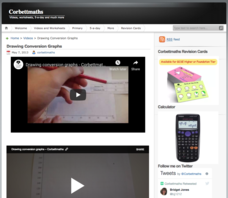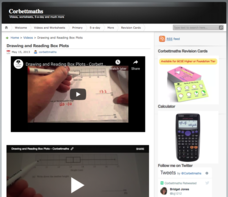California Academy of Science
Think Before You Eat
Small changes in individual diets add up quickly, which is the theme of the ninth lesson in the 13-part Our Hungry Planet unit. Viewers watch a video to learn basic facts before reading a handout and discussing their own choices.
California Academy of Science
Nuclear Energy: Is Fission the Future?
Nuclear energy powers the Mars rovers as well as provides energy in more than 30 countries around the world. While some believe nuclear energy is the future of energy production, others worry about the risk factors and radioactive waste....
PBS
When We First Walked
Out of all mammals, only humans walk on two feet. Discuss the current scientific understanding of when this specific adaptation began. A video shares facts about many different species and theories about why the shift occurred. New...
PBS
Life, Sex, and Death Among the Dire Wolves
Scientists know a great deal about extinct dire wolves thanks to a large number fossilized in one geographical area. They lived in groups, hunted opportunistic or wounded prey, and were fierce in battle and sex. Learn more with an...
Mathispower4u
Application of a Linear Equation in One Variable - Equal Saving Amount (Example)
Explore the idea of equality through the lens of linear equations. Two friends have a specific amount of money in savings and plan to add to it each week. A video lesson shows how to determine when their total amounts in savings is...
Mathispower4u
Application of a Linear Equation in One Variable - Salary Plus Commission (Example 1)
Build problem-solving skills within your classes. Young scholars learn linear equations are great for modeling contextual situations. The specific situation models weekly income based on a combination of salary and commission. Given the...
Mathispower4u
Linear Equation Application - Depth Under Water (Example)
Water pressure decreases at a constant rate with a change in depth. A video lesson demonstrates how to use a linear equation to determine the depth when given a specific pressure. Learners must substitute for the dependent variable to...
Mathispower4u
Writing Linear Equations to Solve Applications
What situations do linear equations model? A video lesson demonstrates how to write a linear equation to represent a specific situation. Learners then watch as the instructor shows how to use the equation to analyze the situation.
Corbett Maths
Reading Cumulative Frequency Graphs
Creating a cumulative frequency graph is one thing, reading them is another. A thorough video lesson explains how to find key information from a cumulative frequency graph. The instructor demonstrates the best way to read the graph and...
Corbett Maths
Drawing Cumulative Frequency Graphs
What's the difference between frequency and cumulative frequency? Young scholars consider the question as they create a cumulative frequency graph. They watch as the frequency totals grow to create a new shape of the graph.
Corbett Maths
Conversion Graphs
Add a new method of converting units to your repertoire! A video lesson describes how to use a graph to convert units. The lesson focuses on miles-to-kilometers and kilometers-to-miles conversions but applies to any type of conversion.
Corbett Maths
Drawing Conversion Graphs
A conversion graph makes quick work of determining unit conversions. A video lesson demonstrates how to create and use a conversion graph. Learners then demonstrate their understanding with provided practice problems.
Corbett Maths
Comparing Box Plots
Stacked box plots create an informative visual display. Using a video lesson, scholars compare data from box plots plotted on the same number line. They use both the visual display and the key intervals to make conclusions.
Corbett Maths
Drawing and Reading Box Plots
Box and whiskers have more to do with data than they do with cats! A video lesson describes how to plot, analyze, and compare box plots. Mathematicians first learn to create a box plot and then how to use information about the quartiles...
Corbett Maths
Reading Bar Charts
Not just a bar graph—it's a double bar graph! Young scholars learn to read a double bar graph as they view the instructional video. The video highlights the individual data as well as shows a comparison between the two sets of data...
Corbett Maths
Drawing Bar Charts
Learn the ins and outs of creating graphical displays. A video lesson demonstrates the process of creating a bar graph from a frequency table. The instructor models each step including labeling axes, determining intervals, and creating...
Corbett Maths
Simultaneous equations (Linear and Quadratic)
Now that budding mathematicians have figured out linear systems, its time to try nonlinear! A video tutorial outlines the steps of solving a linear-quadratic system of equations. The instructor demonstrates each step of the process using...
Corbett Maths
Solving Simultaneous Equations by Substitution
Substitution is a key concept in algebra—with many more uses than just solving linear systems. Build an integral foundational skill using a video tutorial and practice options in a well-designed lesson. The video offers multiple examples...
Corbett Maths
Simultaneous Equations – Elimination Method
There are many methods for solving a system of linear equations. A thorough lesson provides a video tutorial describing one of those methods. The instructor gives step-by-step directions for using the elimination method including adding...
Crash Course
ANOVA Part 2: Dealing with Intersectional Groups: Crash Course Statistics #34
A statistic of interest is often affected by multiple variables. Continuing from the previous lesson in the Crash Course Statistics playlist, the instructor explains how to apply the ANOVA calculations to multiple variables that have an...
Crash Course
ANOVA: Crash Course Statistics #33
How do you account for multiple variables when analyzing data? Following a lesson on regression, the 33rd lesson in the Crash Course Statistics series examines the ANOVA, analysis of variances, method of determining differences...
Crash Course
Regression: Crash Course Statistics #32
Regression models help make sense of statistical data and assist people in making predictions describing the world around us. A thorough video lesson discusses linear regression models and concepts related to the models, such as...
California Academy of Science
Bugs for Breakfast
More people in the world eat bugs as a source of protein than the number of people who don't eat bugs. Viewers consider bugs as a food source to solve multiple issues. Our Hungry Planet introduces bug-based food as a possible solution to...
California Academy of Science
Why Protect Pollinators?
Would you rather having biting flies or chocolate? The question may seem absurd, but cocoa trees rely on pollination from biting flies. Viewers come to understand the importance of pollinators to our food supply, flowers, and entire...























